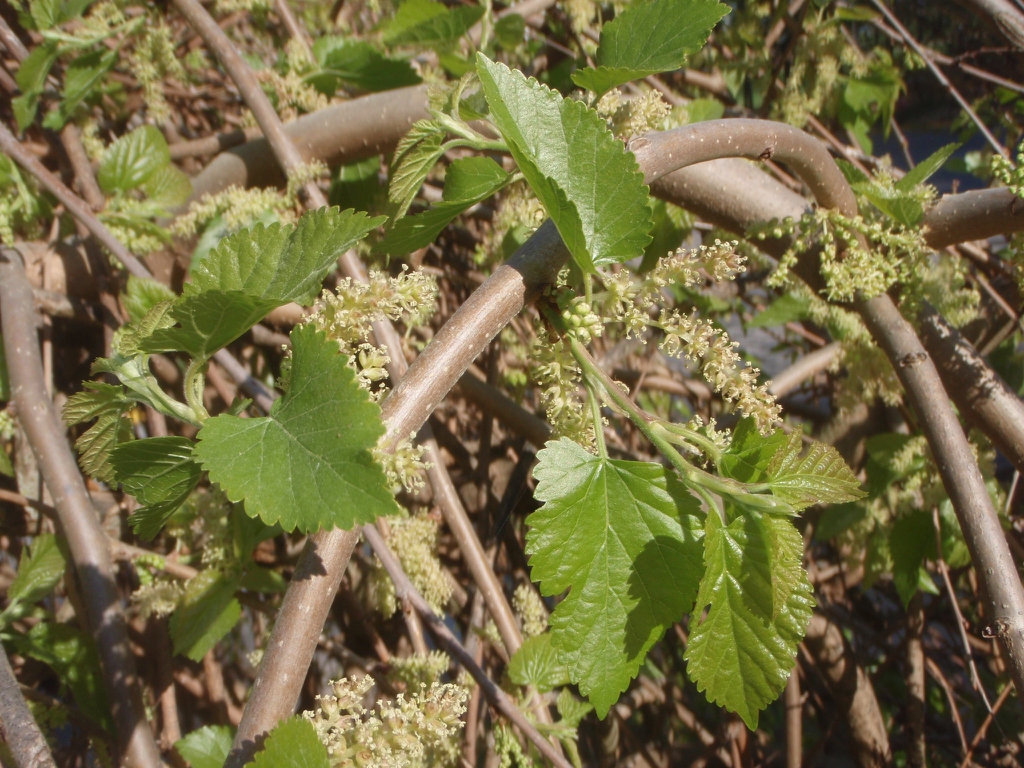Morus alba
Common Name(s):
- Phonetic Spelling
- MOR-us AL-bah
- This plant has low severity poison characteristics.
- See below
- Description
-
Plants exude a milky sap from young twigs when broken. Male and female flowers form on separate plants. The fruits are relished by birds, but dropped fruit can cause maintenance issues such as staining concrete walkways, patios, and cars; be aware of where their canopy will extend when choosing the location to plant one of these trees. Many gardeners feel they have no place in the home landscape as a fruit or specimen tree. These trees can become weedy. Herbicides are not effective, the best management is to hand pull seedlings when young. Considered invasive in some parts of the country.
This plant may be seen in naturalized areas. It is resistant to drought and pollution, while also attracting songbirds.
Able to hybridize with the native red mulberry.
- See this plant in the following landscape:
- Cultivars / Varieties:
-
- 'Pendula'
- 'Pendula'
- 'Pendula'
- Tags:


























- Cultivars / Varieties:
-
- 'Pendula'
- 'Pendula'
- 'Pendula'
- Tags:
-
-
Attributes:
- Genus:
- Morus
- Species:
- alba
- Family:
- Moraceae
- Uses (Ethnobotany):
- Leaves are used to feed the silk worm
- Life Cycle:
- Woody
- Country Or Region Of Origin:
- China
- Wildlife Value:
- Birds love the fruit. Also eaten by Opossum, Raccoon, Fox Squirrel, and Gray Squirrel; White-Tailed Deer browse on the leaves and twigs, while beavers gnaw on the wood.
- Edibility:
- Ripe fruits are eaten raw or made into pies, jellies, and jams. Dried fruits can be added to bread, cookies, or puddings like raisins.
- Dimensions:
- Height: 30 ft. 0 in. - 60 ft. 0 in.
- Width: 20 ft. 0 in. - 40 ft. 0 in.
-
-
Whole Plant Traits:
- Plant Type:
- Edible
- Poisonous
- Tree
- Weed
- Woody Plant Leaf Characteristics:
- Deciduous
- Habit/Form:
- Rounded
- Growth Rate:
- Rapid
- Maintenance:
- High
-
-
Cultural Conditions:
- Light:
- Full sun (6 or more hours of direct sunlight a day)
- Soil Texture:
- Clay
- Loam (Silt)
- Sand
- Soil pH:
- Alkaline (>8.0)
- Neutral (6.0-8.0)
- Soil Drainage:
- Good Drainage
- Available Space To Plant:
- 12-24 feet
- NC Region:
- Coastal
- Mountains
- Piedmont
- USDA Plant Hardiness Zone:
- 4a, 4b, 5a, 5b, 6a, 6b, 7a, 7b, 8a, 8b
-
-
Fruit:
- Fruit Color:
- Pink
- Purple/Lavender
- White
- Fruit Value To Gardener:
- Edible
- Display/Harvest Time:
- Fall
- Fruit Type:
- Berry
- Fruit Description:
- Clustered like a blackberry
-
-
Flowers:
- Flower Color:
- Green
- Flower Inflorescence:
- Catkin
- Insignificant
- Flower Bloom Time:
- Spring
- Flower Description:
- Flowers small in a tight cluster
-
-
Leaves:
- Woody Plant Leaf Characteristics:
- Deciduous
- Leaf Color:
- Green
- Leaf Feel:
- Glossy
- Smooth
- Leaf Type:
- Simple
- Leaf Arrangement:
- Alternate
- Leaf Shape:
- Ovate
- Leaf Margin:
- Crenate
- Lobed
- Serrate
- Hairs Present:
- No
- Leaf Length:
- 3-6 inches
- Leaf Width:
- 1-3 inches
- Leaf Description:
- Alternate, simple, toothed leaves, either unlobed, mitten-shaped, or 3-lobed, usually smooth above and hairless below
-
-
Bark:
- Bark Color:
- Dark Brown
- Dark Gray
- Surface/Attachment:
- Ridges
- Bark Description:
- Trunk bark is usually greyish-brown with flattened ridges and shallow vertical furrows; on very old trees, the bark becomes gray and coarse with curving deep furrows.
-
-
Stem:
- Stem Is Aromatic:
- No
-
-
Landscape:
- Problems:
- Messy
- Poisonous to Humans
- Problem for Children
- Weedy







